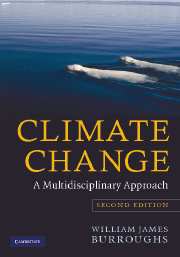Book contents
- Frontmatter
- Contents
- Preface to the second edition
- 1 Introduction
- 2 Radiation and the Earth's energy balance
- 3 The elements of the climate
- 4 The measurement of climate change
- 5 Statistics, significance and cycles
- 6 The natural causes of climate change
- 7 Human activities
- 8 Evidence of climate change
- 9 Consequences of climate change
- 10 Modelling the climate
- 11 Predicting climate change
- Glossary
- Bibliography
- Index
8 - Evidence of climate change
Published online by Cambridge University Press: 05 June 2012
- Frontmatter
- Contents
- Preface to the second edition
- 1 Introduction
- 2 Radiation and the Earth's energy balance
- 3 The elements of the climate
- 4 The measurement of climate change
- 5 Statistics, significance and cycles
- 6 The natural causes of climate change
- 7 Human activities
- 8 Evidence of climate change
- 9 Consequences of climate change
- 10 Modelling the climate
- 11 Predicting climate change
- Glossary
- Bibliography
- Index
Summary
Time, which antiquates antiquities, and hath an art to make dust of all things, hath yet spared these minor monuments.
Sir Thomas Browne, 1605–82Turning to the evidence of climate change, much of what we have to work with is circumstantial and fragmentary; in effect only a few pieces of a jigsaw. Differing interpretations can be put on what actually could have occurred and what the causes might have been for the proposed changes. This analysis requires continual re-evaluation as more evidence becomes available or improved measurement techniques enable the existing evidence to be reappraised in a more critical light. For example, the holding of Frost Fairs on the frozen River Thames in London during the seventeenth and eighteenth centuries have long been seen as confirmation of the winters being much colder then. But, how much can we read into a few extremely cold seasons? Moreover, how do we take account of the fact that the old London Bridge, which was removed in 1831, acted as a weir to slow down the flow of the river? Combined with the absence of embankments, which meant the river was much wider, and the lack of waste heat from industrial plants, ensured that the river froze much more readily in cold weather. Only with the careful examination of instrumental records (see Section 4.1) did it become clear that winters were on average 1 °C colder; a smaller difference than might be inferred by relying on the records of Frost Fairs alone.
- Type
- Chapter
- Information
- Climate ChangeA Multidisciplinary Approach, pp. 212 - 269Publisher: Cambridge University PressPrint publication year: 2007



